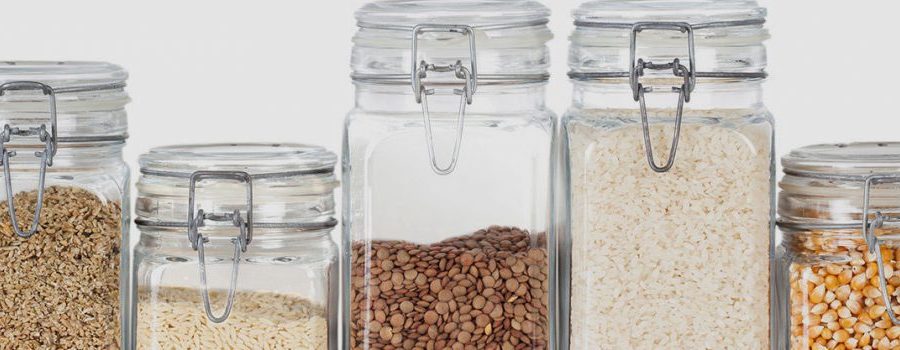Keeping a well-stocked pantry means you always have what you need for a wholesome homemade meal. Storing essential items on your shelves helps you quickly pull together a delicious meal or snack quicker than making a trip to the drive-through. Pantry planning can help you tighten your budget, too. With the right selection of ingredients, you can create a huge variety of meals from different cuisines. These basic food items will enable you to build or revamp your pantry and can be customized to your family’s preferences.
Oils & Vinegars
These key flavour-building ingredients are must-haves.
- Canola oil is good for frying, stir-frying or sautéing. Its smoke point is fairly high, so it won’t burn.
- Extra-virgin olive oil is an ideal finishing touch, drizzled over flatbreads or pasta, or for use in vinaigrettes.
- Sesame seed and nut oils have distinct flavours that can boost the taste of salads, noodle dishes and soups.
Balsamic, red wine and white wine vinegars provide tangy flavour as an ingredient in dressings, vinaigrettes, marinades and easy no-cook salsas.
Storage Tips: Oil and vinegar should be kept in a cool, dark, dry place in your pantry. Don’t store beside the stove or in front of a kitchen window, as the heat and light can degrade them. Nut oils are more perishable and should be refrigerated after opening.
Herbs, Spices & Salts
Give meals layers of flavour with these suggestions, and find more ideas in our handy guide to using herbs.
- Dried basil, dill, thyme and oregano add an aromatic note to everything from proteins and whole grains to vegetables and pasta dishes.
- Dried ginger, Chinese five-spice and curry blends are great to have in your pantry if your family likes the strong flavours of Asian and Indian dishes. If Latin American recipes are your family’s favourites, stock up on ground cumin, paprika and chilies.
- Black pepper is a must-have (ideally in a pepper grinder, so it’s always freshly ground), along with crushed red chili flakes. Use them to add heat and to punch up flavour in everything from soups and stews to sauces, dressings and marinades to omelettes and grain dishes.
- Cinnamon, vanilla and nutmeg are staple spices for baking, and can even be used to give savoury meat dishes an unexpected kick. If you’re a keen baker, consider whole versions of these spices. Freshly grated cinnamon and nutmeg, and whole vanilla beans tend to have a fresher flavour than when you purchase them pre-ground or in extract form.
- In addition to table salt, sea salt or kosher salt will help to bring out the best flavours in your cooking and baking.
Storage Tips: Dried herbs and spices last for months or longer, though their flavour does fade over time. (If you’ve had a jar for years, it might be time to restock.) Whole spices require a little more effort on your part, since you have to grind them before use, but they retain their flavour longer than pre-ground versions. Store herbs and spices away from direct heat and light for optimal freshness.
Pasta, Grains & Legumes
Use these as the base for quick and delicious go-to meals when time’s running short and a hungry clan descends.
- Pasta is easy to make, inexpensive and crowd pleasing. Keep a stock of your family’s preferred varieties, such as spaghetti, rigatoni and macaroni. If gluten is a concern, have gluten-free options on hand – they cook up and taste just like the real deal.
- Asian rice noodles are essential for making a pad Thai or stir-fry.
- Dried beans, chickpeas and lentils are budget friendly and nourishing. Cook them in big batches (dried beans and chickpeas need to be soaked for eight hours or overnight first) and freeze family-sized portions for later use in dips, chili, soups or stews.
- Canned beans and chickpeas: No time to cook dried beans? Buy canned instead.
- Quinoa, barley and brown or white rice can be quickly prepared and cooked in big batches, then frozen for easy reheating.
Storage Tips: If you buy dried legumes in bulk, store them in clear containers, such as large glass jars, rather than in plastic bags. Note on the container the date you bought them, and keep in a dry, cool place to extend shelf life.
Flours & Sweeteners
Even if you’re not a baker, having flour and sweeteners on hand can expand your meal options.
- All-purpose flour is key for whipping up baked goods, making roux for gumbo, and thickening sauces, gravies or puddings. If you’re gluten intolerant, cornstarch and rice flour work as replacements.
- White, brown or raw cane sugar can be used in everything from salsas and sauces to condiments and pickling, and can also balance out vinaigrettes and marinades. In many applications, you can use maple syrup or honeyinstead.
Storage Tips: Clean, dry containers with good lids are ideal for flours, sugars and sweeteners, which should be stored in cool, dark cupboards. Pure maple syrup should be refrigerated after opening.
Sauces & Condiments
A good sauce or condiment can instantly turn a ho-hum dish into a crowd-pleaser.
- Mustard, ketchup, mayonnaise, soy sauce, tomato sauce, fish sauce and hot sauce are must-have condiments for meals such as burgers, sandwiches and sushi. Dijon mustard livens up vinaigrettes, fish sauce adds more savoury flavour to Asian-style stir-fries and noodle dishes, and hot sauces can be introduced into any dish where a little heat is desired. Mayonnaise swirled with a little mustard or hot sauce doubles as a dip as well.
- Broth (vegetable, chicken or beef), available in easy-to-use Tetra Paks, gives you an instant base for soups, stews and chili. Used in place of water, it also adds depth of flavour to rice or grain dishes.
Storage Tips: Most of the condiments mentioned above can be kept in the pantry unopened for a year. Once opened, though, their shelf lives vary. For example, mustard is good for a year in the fridge, while ketchup should be used up within six months. Check the “best before” dates on your condiments and sauces regularly to be sure they’re still good.
Nuts & Seeds
These tasty foods from plants give dishes textural interest and a nutty nuance.
- Almonds, walnuts and peanuts make for easy snacks and add delicious crunch to Asian-style noodle dishes, rice pilafs, yogourt and salads. Along with seeds, such as pumpkin, sesame or sunflower, they form the base for homemade trail mix and morning granola.
- Nut butters, such as almond and peanut, are irresistible as sandwich spreads, blended into smoothies or mixed into sauces. Tahini, or sesame seed butter, adds essential depth of flavour to hummus.
- Canned coconut milk lends its slightly sweet taste and creamy texture to everything from spicy curries and soups to smoothies and desserts.
Storage Tips: Keep nuts and seeds in clean, dry containers away from heat and light. Ground nuts and seeds have a shorter shelf life, so store them in the freezer, or buy whole and grind at home. A general shelf-life guideline: store nuts and seeds for three months at room temperature, six months in the fridge or a year in the freezer.
Canned Fruits & Vegetables
These handy foods store well and bring fruit flavour to even the simplest meals.
- Tomatoes (whole, crushed, diced, or as a sauce or paste) are a classic ingredient in pasta sauce, soup and chili.
- Peas, corn and mushrooms can be used in sauces, soups and casseroles.
- Olives make a great tapas snack when company comes. They’re also delicious in green or tuna salads, stirred into pastas or added to homemade pizza.
- Unsweetened fruit sauces, such as applesauce, make simple snacks or yogourt mix-ins, and can be used as a sweetener for coffee cakes and other baked goods.
- Canned fruit (for example, pineapple, peaches or apricots) can be dessert on its own. Spoon over ice cream or waffles for a sweet treat.
Storage Tips: Commercially canned goods should be kept in a cool, dry place and will last two to five years unopened. Once opened, canned fruit and vegetables should be removed from the can and are good for one to five days refrigerated, depending on the food.
 Back to myNiagaraOnline
Back to myNiagaraOnline
































